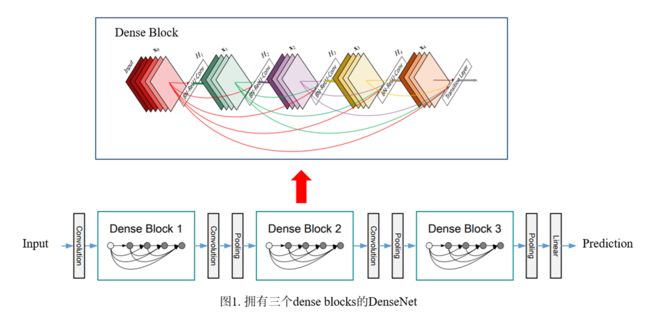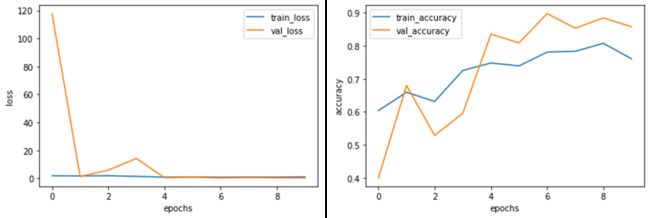【图像分类案例】(2) DenseNet 天气图片四分类(权重迁移学习),附Tensorflow完整代码
各位同学好,今天和大家分享一下使用 Tensorflow 构建 DenseNet 卷积神经网络模型,并使用预训练模型的权重,完成对四种天气图片的分类。
完整代码在我的 Gitee 中,有需要的自取:
https://gitee.com/dgvv4/image-classification/tree/master
1. DenseNet
1. 网络介绍
DenseNet 采用密集连接机制,即互相连接的所有层,每个层都会与前面所有层在通道维度上堆叠(layers.Concate),实现特征重用,作为下一层的输入。这样,不但缓解了梯度消失的现象,也使其可以在参与计算量更少的情况下实现比 ResNet 更优的性能。
DenseNet 的密集连接方式需要特征图大小保持一致,所以 DenseNet 网络中使用 DenseBlock + Transition 的结构。DenseBlock 是包含很多层的模块,每个层特征图大小相同,层与层之间采用密集连接方式。Transition模块是连接两个相邻的DenseBlock,并且通过池化层完成下采样。
1.2 DenseBlock代码复现
假定输入层的特征图的通道数为 k0,且DenseBlock中各层卷积输出特征图的通道数为 k。那么第L层的输入特征图的通道数是 k0+(L-1)k,我们将k成为网络的增长率(growth_rate)
因为每一层都接收前面的所有层的特征图,即特征传递方式是直接将前面所有层的特征图堆叠(layers.Concate)传到下一层。
DenseBlock 采用激活函数在前,卷积层在后的顺序,即BN+ReLU+Conv的顺序,在DenseNet中该排序方法网络的性能较好。
DenseBlock 内部采用了1*1卷积减少参数量,将前面层的堆叠的通道数下降为4*k个,降低特征输了,提高计算效率。
代码展示:
#(1)构建一个dense单元
def DenseLayer(x, growth_rate, dropout_rate=0.2):
# BN+激活+1*1卷积降维
x = layers.BatchNormalization()(x)
x = layers.Activation('relu')(x)
x = layers.Conv2D(filters = growth_rate*4, # 降低特征图数量
kernel_size = (1,1),
strides = 1,
padding = 'same')(x)
# BN+激活+3*3卷积
x = layers.BatchNormalization()(x)
x = layers.Activation('relu')(x)
x = layers.Conv2D(filters = growth_rate,
kernel_size = (3,3),
strides = 1,
padding = 'same')(x)
# 随机杀死神经元
x = layers.Dropout(rate = dropout_rate)(x)
return x
#(2)构建DenseBlock的多个卷积组合在一起的卷积块
def DenseBlock(x, num, growth_rate):
# 重复执行多少次DenseLayer
for _ in range(num):
conv = DenseLayer(x, growth_rate)
# 将前面所有层的特征堆叠后传到下一层
x = layers.Concatenate()([x, conv])
return x1.3 Transition 代码展示
Transition 模块主要连接两个相邻的 DenseBlock,并下采样降低特征图的size,压缩模型。Transition层包含一个1*1卷积层和2*2平均池化层。
#(3)Transition层连接两个相邻的DenseBlock
def Transition(x, compression_rate=0.5):
# 1*1卷积下降一半的通道数
out_channel = int(x.shape[-1] * compression_rate)
# BN+激活+1*1卷积+2*2平均池化
x = layers.BatchNormalization()(x)
x = layers.Activation('relu')(x)
x = layers.Conv2D(filters = out_channel, # 输出通道数
kernel_size = (1,1),
strides = 1,
padding = 'same')(x)
x = layers.AveragePooling2D(pool_size = (2,2),
strides = 2, # 下采样
padding = 'same')(x)
return x1.4 构造主干网络
网络结构图如下,我以 DenseNet121 为例构建网络骨干。
#(4)主干网络架构
def densenet(input_shape, classes, growth_rate, include_top):
# 构造输入层[224,224,3]
inputs = keras.Input(shape=input_shape)
# 卷积下采样[224,224,3]==>[112,112,64]
x = layers.Conv2D(filters = 2*growth_rate, # 输出特征图个数为两倍增长率
kernel_size = (7,7),
strides = 2,
padding = 'same')(inputs)
x = layers.BatchNormalization()(x)
x = layers.Activation('relu')(x)
# 最大池化[112,112,64]==>[56,56,64]
x = layers.MaxPooling2D(pool_size = (3,3),
strides = 2,
padding = 'same')(x)
# [56,56,64]==>[56,56,64+6*32]
x = DenseBlock(x, num=6, growth_rate=growth_rate)
# [56,56,256]==>[28,28,128]
x = Transition(x)
# [28,28,128]==>[28,28,128+12*32]
x = DenseBlock(x, num=12, growth_rate=growth_rate)
# [28,28,512]==>[14,14,256]
x = Transition(x)
# [14,14,256]==>[14,14,256+24*32]
x = DenseBlock(x, num=24, growth_rate=growth_rate)
# [14,14,1024]==>[7,7,512]
x = Transition(x)
# [7,7,512]==>[7,7,512+16*32]
x = DenseBlock(x, num=16, growth_rate=growth_rate)
# 导入模型时,是否包含输出层
if include_top is True:
# [7,7,1024]==>[None,1024]
x = layers.GlobalAveragePooling2D()(x)
# [None,1024]==>[None,classes]
x = layers.Dense(classes)(x) # 不经过softmax层转换成概率
# 构造模型
model = Model(inputs, x)
return model
#(5)接收网络模型
if __name__ == '__main__':
model = densenet(input_shape=[224,224,3], # 输入图像的shape
classes = 1000, # 分类数
growth_rate = 32, # 设置增长率,即每个dense模块的输出通道数
include_top = True) # 默认包含输出层
model.summary() # 查看网络架构2. 网络训练
2.1 加载数据集
函数 tf.keras.preprocessing.image_dataset_from_directory() 构造数据集,
分批次读取图片数据,参数 img_size 会对读进来的图片resize成指定大小;参数 label_mode 中,'int'代表目标值y是数值类型索引,即0, 1, 2, 3等;'categorical'代表onehot类型,对应正确类别的索引的值为1,如图像属于第二类则表示为0,1,0,0,0;'binary'代表二分类。
#(1)加载数据集
def get_data(height, width, batchsz):
# 训练集数据
train_ds = keras.preprocessing.image_dataset_from_directory(
directory = filepath + 'train', # 训练集图片所在文件夹
label_mode = 'categorical', # onehot编码
image_size = (height, width), # 输入图象的size
batch_size = batchsz) # 每批次训练32张图片
# 验证集数据
val_ds = keras.preprocessing.image_dataset_from_directory(
directory = filepath + 'val',
label_mode = 'categorical',
image_size = (height, width),
batch_size = batchsz)
# 返回划分好的数据集
return train_ds, val_ds
# 读取数据集
train_ds, val_ds = get_data(height, width, batchsz)
#(2)查看数据集信息
def check_data(train_ds): # 传入训练集数据集
# 查看数据集有几个分类类别
class_names = train_ds.class_names
print('classNames:', class_names)
# 查看数据集的shape, x代表图片数据, y代表分类类别数据
sample = next(iter(train_ds)) # 生成迭代器,每次取出一个batch的数据
print('x_batch.shape:', sample[0].shape, 'y_batch.shape:', sample[1].shape)
print('前五个目标值:', sample[1][:5])
# 是否查看数据集信息
if checkData is True:
check_data(train_ds)
#(3)查看图像
def plot_show(train_ds):
# 生成迭代器,每次取出一个batch的数据
sample = next(iter(train_ds)) # sample[0]图像信息, sample[1]标签信息
# 显示前5张图
for i in range(5):
plt.subplot(1,5,i+1) # 在一块画板的子画板上绘制1行5列
plt.imshow(sample[0][i]/255.0) # 图像的像素值压缩到0-1
plt.xticks([]) # 不显示xy坐标刻度
plt.yticks([])
plt.show()
# 是否展示图像信息
if plotShow is True:
plot_show(train_ds)天气图片如下:
2.2 预处理改进
本篇使用迁移学习的方法,使用 DenseNet121 预训练模型的权重训练网络,大体流程和上一篇文章的非迁移学习训练方法类似,这里只说明一下需要改动的地方。可见上一篇案例:https://blog.csdn.net/dgvv4/article/details/123714507
首先,既然使用了别人训练好的权重继续训练,那就要使用和别人一样的数据预处理方法。
在imgnet中数据的预处理方法是,输入图像的各个通道的像素值都减去其均值,不使用像素值归一化的方法。
# 数据预处理不使用归一化,调整RGB三通道颜色均值
_R_MEAN = 123.68
_G_MEAN = 116.78
_B_MEAN = 103.94
#(4)数据预处理
def processing(x,y): # 定义预处理函数
x = tf.cast(x, dtype=tf.float32) # 图片转换为tensor类型
y = tf.cast(y, dtype=tf.int32) # 分类标签转换成tensor类型
# 对图像的各个通道减去均值,不进行归一化
x = x - [_R_MEAN, _G_MEAN, _B_MEAN]
return x,y
# 对所有数据预处理
train_ds = train_ds.map(processing).shuffle(10000) # map调用自定义预处理函数, shuffle打乱数据集
val_ds = val_ds.map(processing)2.3 加载模型和权重
其次,加载网络模型及权重,我们只需要网络的特征提取层,不需要网络的输出层(原网络输出一般都是1000分类)。通过设置 model.trainable = False 就能冻结网络特征提取层的所有权重,正反向传播过程中只有输出层的权重会发生优化更新。建议前10轮的训练冻结特征提取层,后面的训练再设置 model.trainable = True 网络所有权重都能更新。
自定义输出层,由于原网络的输出层一般都是1000分类,而我们自己的网络一般是几个分类,因此输出层的网络结构需要我们自己写。通过 keras.Sequential() 容器堆叠网络各层。
model = densenet(input_shape=input_shape, # 网络的输入图像的size
classes=classes, # 分类数
growth_rate = 32, # 设置增长率,即每个dense模块的输出通道数
include_top=False) # 不载入输出层
# 报错解决:You are trying to load a weight file containing 242 layers into a model with
# 添加参数:by_name=True
model.load_weights(pre_weights_path, by_name=True)
# False冻结模型的所有参数,只能更新输出层的参数
model.trainable = True
# 自定义输出层,不经过softmax激活,有利于网络的稳定性
model = keras.Sequential([model, # [7,7,1024]
layers.GlobalAveragePooling2D(), # ==>[None,1024]
layers.Dropout(rate=0.5),
layers.Dense(512), # ==>[None,512]
layers.Dropout(rate=0.5),
layers.Dense(classes)]) #==>[None,classes] 2.4 训练结果
和非迁移学习的训练方法相比需要改进的部分只有上面两点,接下来开始训练,设置回调函数将验证集损失最低的一次迭代的权重保存下来。
#(7)保存权重文件
if not os.path.exists(weights_dir): # 判断当前文件夹下有没有一个叫save_weights的文件夹
os.makedirs(weights_dir) # 如果没有就创建一个
#(8)模型编译
opt = optimizers.Adam(learning_rate=learning_rate) # 设置Adam优化器
model.compile(optimizer=opt, #学习率
loss=keras.losses.CategoricalCrossentropy(from_logits=True), # 交叉熵损失,logits层先经过softmax
metrics=['accuracy']) #评价指标
#(9)定义回调函数,一个列表
# 保存模型参数
callbacks = [keras.callbacks.ModelCheckpoint(filepath = 'save_weights/densenet.h5', # 参数保存的位置
save_best_only = True, # 保存最佳参数
save_weights_only = True, # 只保存权重文件
monitor = 'val_loss')] # 通过验证集损失判断是否是最佳参数
#(10)模型训练,history保存训练信息
history = model.fit(x = train_ds, # 训练集
validation_data = val_ds, # 验证集
epochs = epochs, #迭代30次
callbacks = callbacks,
initial_epoch=0) 训练完成后,history中保存了训练信息,绘制损失曲线和准确率曲线。
#(11)获取训练信息
history_dict = history.history # 获取训练的数据字典
train_loss = history_dict['loss'] # 训练集损失
train_accuracy = history_dict['accuracy'] # 训练集准确率
val_loss = history_dict['val_loss'] # 验证集损失
val_accuracy = history_dict['val_accuracy'] # 验证集准确率
#(12)绘制训练损失和验证损失
plt.figure()
plt.plot(range(epochs), train_loss, label='train_loss') # 训练集损失
plt.plot(range(epochs), val_loss, label='val_loss') # 验证集损失
plt.legend() # 显示标签
plt.xlabel('epochs')
plt.ylabel('loss')
#(13)绘制训练集和验证集准确率
plt.figure()
plt.plot(range(epochs), train_accuracy, label='train_accuracy') # 训练集准确率
plt.plot(range(epochs), val_accuracy, label='val_accuracy') # 验证集准确率
plt.legend()
plt.xlabel('epochs')
plt.ylabel('accuracy')训练过程中的准确率和损失
Epoch 1/10
99/99 [==============================] - 64s 354ms/step - loss: 1.8832 - accuracy: 0.5543 - val_loss: 117.8199 - val_accuracy: 0.4000
Epoch 2/10
99/99 [==============================] - 16s 140ms/step - loss: 1.5482 - accuracy: 0.6619 - val_loss: 1.3441 - val_accuracy: 0.6800
Epoch 3/10
99/99 [==============================] - 16s 138ms/step - loss: 2.0702 - accuracy: 0.6129 - val_loss: 5.8502 - val_accuracy: 0.5289
Epoch 4/10
99/99 [==============================] - 16s 137ms/step - loss: 1.2101 - accuracy: 0.7477 - val_loss: 14.2739 - val_accuracy: 0.5956
Epoch 5/10
99/99 [==============================] - 15s 137ms/step - loss: 0.7785 - accuracy: 0.7687 - val_loss: 0.4700 - val_accuracy: 0.8356
Epoch 6/10
99/99 [==============================] - 16s 138ms/step - loss: 1.1095 - accuracy: 0.7349 - val_loss: 0.8931 - val_accuracy: 0.8089
Epoch 7/10
99/99 [==============================] - 16s 138ms/step - loss: 0.8705 - accuracy: 0.7835 - val_loss: 0.2821 - val_accuracy: 0.8978
Epoch 8/10
99/99 [==============================] - 16s 138ms/step - loss: 0.9680 - accuracy: 0.7760 - val_loss: 0.6360 - val_accuracy: 0.8533
Epoch 9/10
99/99 [==============================] - 16s 139ms/step - loss: 0.9522 - accuracy: 0.8041 - val_loss: 0.3987 - val_accuracy: 0.8844
Epoch 10/10
99/99 [==============================] - 16s 138ms/step - loss: 1.0262 - accuracy: 0.7649 - val_loss: 0.4000 - val_accuracy: 0.85783. 预测阶段
以对整个测试集的图片预测为例,test_ds 存放测试集的图片和类别标签,对测试集进行和训练集相同的预处理方法,将图片的每个通道像素值减去每个通道的均值。
model.predict(img) 返回的是每张图片属于每个类别的概率,需要找到概率最大值所对应的索引 np.argmax(result),该索引对应的分类名称就是最终预测结果。
import tensorflow as tf
from tensorflow import keras
from DenseNet import densenet
from PIL import Image
import numpy as np
import matplotlib.pyplot as plt
# 报错解决:NotFoundError: No algorithm worked! when using Conv2D
from tensorflow.compat.v1 import ConfigProto
from tensorflow.compat.v1 import InteractiveSession
config = ConfigProto()
config.gpu_options.allow_growth = True
session = InteractiveSession(config=config)
# ------------------------------------ #
# 预测参数设置
# ------------------------------------ #
im_height = 224 # 输入图像的高
im_width = 224 # 输入图像的高
# 分类名称
class_names = ['cloudy', 'rain', 'shine', 'sunrise']
# 权重路径
weight_dir = 'save_weights/densenet_new.h5'
# ------------------------------------ #
# 数据预处理,调整RGB三通道颜色均值
# ------------------------------------ #
_R_MEAN = 123.68
_G_MEAN = 116.78
_B_MEAN = 103.94
# ------------------------------------ #
# 单张图片预测
# ------------------------------------ #
# 是否只预测一张图
single_pic = False
# 图像所在文件夹的路径
single_filepath = 'D:/deeplearning/test/....../001.jpg'
# 指定某张图片
picture = single_filepath + 'rain94.jpg'
# ------------------------------------ #
# 对测试集图片预测
# ------------------------------------ #
test_pack = True
# 验证集文件夹路径
test_filepath = 'D:/deeplearning/test/数据集/...../test/'
#(1)载入模型,不载入输出层
model = densenet(input_shape=[224,224,3], classes=4, growth_rate = 32, include_top=False)
print('model is loaded')
#(2)构造输出层
model = keras.Sequential([model,
keras.layers.GlobalAveragePooling2D(), # ==>[None,1024]
keras.layers.Dropout(rate=0.5),
keras.layers.Dense(512), # ==>[None,512]
keras.layers.Dropout(rate=0.5),
keras.layers.Dense(len(class_names)), #==>[None,classes]
keras.layers.Softmax()]) # 这里需要经过得到softmax分类概率
#(3)载入权重.h文件
model.load_weights(weight_dir, by_name=True)
print('weights is loaded')
#(4)只对单张图像预测
if single_pic is True:
# 加载图片
img = Image.open(picture)
# 改变图片size
img = img.resize((im_height, im_width))
# 展示图像
plt.figure()
plt.imshow(img)
plt.xticks([])
plt.yticks([])
# 预处理,图像像素值减去均值
img = np.array(img).astype(np.float32) # 变成tensor类型
img = img - [_R_MEAN, _G_MEAN, _B_MEAN]
# 输入网络的要求,给图像增加一个batch维度, [h,w,c]==>[b,h,w,c]
img = np.expand_dims(img, axis=0)
# 预测图片,返回结果包含batch维度[b,n]
result = model.predict(img)
# 转换成一维,挤压掉batch维度
result = np.squeeze(result)
# 找到概率最大值对应的索引
predict_class = np.argmax(result)
# 打印预测类别及概率
print('class:', class_names[predict_class],
'prob:', result[predict_class])
plt.title(f'{class_names[predict_class]}')
plt.show()
#(5)对测试集图像预测
if test_pack is True:
# 载入测试集
test_ds = keras.preprocessing.image_dataset_from_directory(
directory = test_filepath,
label_mode = 'int', # 不经过ont编码, 1、2、3、4、、、
image_size = (im_height, im_width), # 测试集的图像resize
batch_size = 32) # 每批次32张图
# 测试集预处理
#(2)数据预处理
def processing(image, label):
image = tf.cast(image, tf.float32) # 修改数据类型
label = tf.cast(label, tf.int32)
# 对图像的各个通道减去均值,不进行归一化
image = image - [_R_MEAN, _G_MEAN, _B_MEAN]
return (image, label)
test_ds = test_ds.map(processing) # 预处理
test_true = [] # 存放真实值
test_pred = [] # 存放预测值
# 遍历测试集所有的batch
for imgs, labels in test_ds:
# 每次每次取出一个batch的一张图像和一个标签
for img, label in zip(imgs, labels):
# 网络输入的要求,给图像增加一个维度[h,w,c]==>[b,h,w,c]
image_array = tf.expand_dims(img, axis=0)
# 预测某一张图片,返回图片属于许多类别的概率
prediction = model.predict(image_array)
# 找到预测概率最大的索引对应的类别
test_pred.append(class_names[np.argmax(prediction)])
# label是真实标签索引
test_true.append(class_names[label])
# 展示结果
print('真实值: ', test_true[:10])
print('预测值: ', test_pred[:10])
# 绘制混淆矩阵
from sklearn.metrics import confusion_matrix
import seaborn as sns
import pandas as pd
plt.rcParams['font.sans-serif'] = ['SimSun'] #宋体
plt.rcParams['font.size'] = 15 #设置字体大小
# 生成混淆矩阵
conf_numpy = confusion_matrix(test_true, test_pred)
# 转换成DataFrame表格类型,设置行列标签
conf_df = pd.DataFrame(conf_numpy, index=class_names, columns=class_names)
# 创建绘图区
plt.figure(figsize=(8,7))
# 生成热力图
sns.heatmap(conf_df, annot=True, fmt="d", cmap="BuPu")
# 设置标签
plt.title('Confusion_Matrix')
plt.xlabel('Predict')
plt.ylabel('True')




